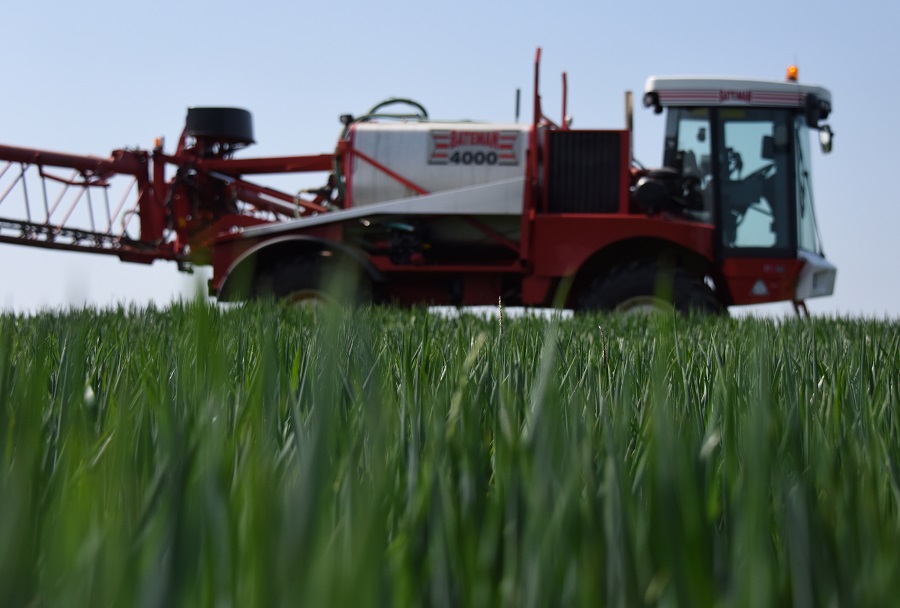Univoq has been launched by Corteva Agriscience, bringing a new mode of action to T2 fungicide programmes. CPM finds out how it works, how it performs and how to look after it.
Inatreq is in a new chemical class.
By Tom Allen-Stevens
Cereal growers have a new fungicide for the flag leaf spray and a new mode of action on septoria – the first to be registered in the UK for 15 years.
Univoq combines Inatreq, the new active from Corteva Agriscience, with prothioconazole. It offers curative and protectant control of all septoria strains, as well as label approval for other major diseases in wheat, rye, triticale and durum wheat. Univoq’s iQ-4 formulation is designed to ensure it sticks to and spreads across the leaf.

Outstanding is how Stuart Jackson describes Univoq’s level of control of septoria in wheat.
“Inatreq is in a new chemical class – the picolinamides and its active ingredient is fenpicoxamid,” explains Dr Greg Kemmitt, global fungicide development lead at Corteva.
“An interesting aspect is that it’s derived from fermentation. We take the streptomyces bacteria and ferment it to produce an antibiotic – UK-2A. Then there’s a single-step modification with this to deliver Inatreq. When it’s sprayed in the field, the novel element of this is that it converts back to the natural product UK-2A inside the plant or fungal tissue, which has the fungicidal activity.”
There’s also a new target site – the first in nearly two decades in cereals. Inatreq is a quinone inside inhibitor (QiI). “This brings it outstanding curative and protective activity against septoria as well as useful activity on leaf rusts,” he says.
Greg explains that fungicides are grouped by the Fungicide Resistance Action Committee (FRAC) according first to their biological effects on the fungal cell, so whether they have an effect on respiration, steroid biosynthesis, or perhaps cell division. They’re then classified according to target site and cross-resistance with those target sites.
“Inatreq affects respiration, sitting in the C4: complex III cytochrome bc1 ubiquinone reductase group. Cyazofamid and amisulbrom, both used for potato blight, also sit here. But unlike these, Inatreq is active on ascomycetes and basidiomycetes fungi. So although they sit in the same group, there’s no cross-resistance because they’re not used against the same pathogen.”
As for its mode of action, Inatreq affects the mitochondria – the power station of fungal cells. It reduces the ability of a cell to produce adenosine triphosphate, an essential protein, inhibiting growth so the fungus dies, continues Greg.
“Strobilurins also bind at complex III, but on the outside of the membrane (QoI) while SDHIs target complex II. So there’s no target-site cross-resistance to other chemistries.”
Tests on UK septoria isolates were carried out at Rothamsted Research by Prof Bart Fraaje. All had G143A mutation for strobilurin resistance and various mutations in Cyp51, conferring varying levels of resistance to triazoles. These were very effectively controlled by Inatreq and fluxapyroxad. Against isolates exhibiting overexpression and one that may also contain a non-specific efflux pump, Inatreq again showed very good control, reports Greg. “When tested on isolates that show a degree of resistance to the SDHI bixafen, Inatreq again gave good control.”
Greg notes the shrinking chemical armoury as actives lose approval and pathogen resistance builds to those remaining. “As this chemistry comes under increasing selection pressure, it’s important we protect it, and that’s where QiI will come in,” he says.
“But history teaches us the risk of resistance to single-site inhibitors is high and FRAC assumes for QiIs it is medium to high. So Inatreq needs a robust resistance management strategy, particularly for septoria.”
Only one QiI-containing product may be applied to a cereal crop in a season, and dose should be adjusted appropriately – 1.5 l/ha is likely to be right for susceptible varieties and locations where septoria is a significant problem, he says.
“Always apply it in a mixture with different MoAs at balanced doses. Use other integrated strategies, such as resistant varieties and decision support systems. All of these elements should be folded into an effective resistance management strategy,” stresses Greg.
Available as the co-formulation Univoq, this offers effective control of major diseases in wheat, notes Stuart Jackson, Corteva technical lead for cereal fungicides.
He points to 2019 trials with KWS Barrel at Sawbridgeworth near Stansted airport comparing T2 doses of Univoq at 1.25 l/ha, 1.5 l/ha and 2 l/ha against a 75% dose of Ascra (bixfen+ fluopyram+ prothioconazole), Elatus Era (benzovindiflupyr+ prothioconazole) and Librax (fluxapyroxad + metconazole).
“There were very high levels of septoria in the untreated plots. Univoq showed outstanding disease control when assessed at 40 days after application, significantly better than the current SDHI offering. This manifests into grain in the shed – significantly increased yield over Ascra,” he adds.
In 2020, Univoq was compared with Ascra and Revystar XE (fluxapyroxad+ mefentrifluconazole) at Ivington near Leominster in AICC trials again on Barrel. Here it gave noticeably better control than Ascra and Revystar, reports Stuart, and again the benefits came through in yield response.
“We put Univoq in yellow rust trials in 2019 at Bishop’s Frome, Herefordshire, on some Reflection with very high levels of yellow rust. Elatus Era and Ascra gave good control when assessed 50 days after application and Univoq performed at least as well as Elatus Era in the trial,” says Stuart.
Brown rust trials were carried out at Little Clacton, Essex in2020 on Crusoe. “Assessed 57 days after treatment was applied, Univoq was every bit as good as the standard Elatus Era treatment.”
Univoq contains 50g/l of fenpicoxamid and 100g/l of prothioconazole with only one dose allowed at a maximum rate of 2 l/ha. It can be used from GS 30-69 to control septoria, yellow rust, brown rust, fusarium, tan spot and powdery mildew in all winter and spring varieties of wheat, rye, triticale and durum wheat. There’s an aquatic buffer zone of 18m and for the first 30m, 3* low-drift nozzles should be used.
Trial comparisons give Univoq the edge
A summary of 24 trials in 2020, in which disease was present throughout the season, compares Univoq at 1.25 l/ha with Revystar at 1 l/ha (top chart above). 58% of the trials showed a yield benefit for Univoq, delivering an overall average yield advantage of 0.14t/ha.
“The trials where it didn’t perform as well as Revystar were brown rust trials where we deliberately didn’t apply a T3 spray,” notes Stuart. “Univoq offers about 3-4 weeks control of brown rust. If you need extra protection, the dose should be increased to 1.5 l/ha, add a partner fungicide for brown rust or follow up with a T3 spray. It was the out-and-out septoria trials where Univoq performed better than Revystar.”
In 2019, Univoq at a 62.5% dose was compared with an 80% dose of Ascra in 60 trials from UK and Ireland (bottom chart above). 73% of trials gave advantage of Univoq over Ascra, delivering an overall average yield of 0.25t/ha. Again, Ascra performed better in brown rust trials, while it was the septoria trials where Univoq came to the fore, notes Stuart.




